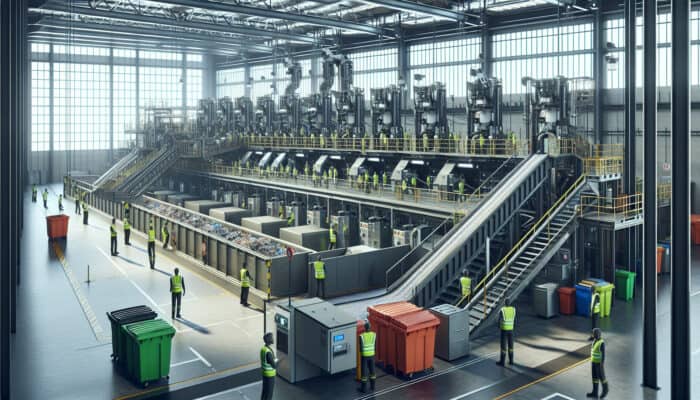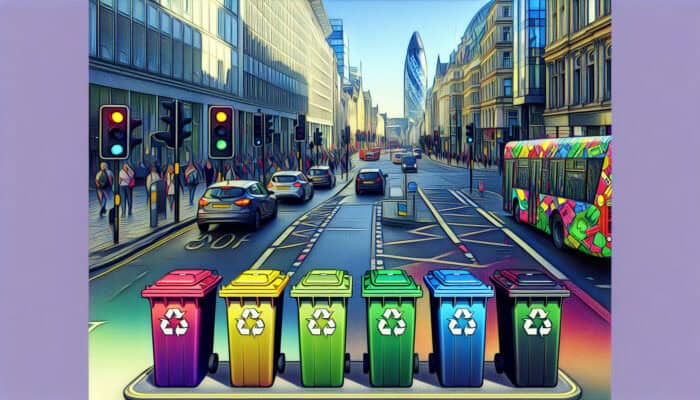Exploring Sustainable Waste Management Practices in the UK
Defining Green Disposal Practices

Green Disposal Options for UK Clearances: Green disposal refers to a set of environmentally friendly waste management techniques designed to reduce the negative ecological effects associated with waste production. In the UK, this approach prioritises recycling, composting, and the careful disposal of hazardous materials. These practices are vital for conserving natural resources and paving the way for a sustainable future, particularly in an era where climate change and environmental challenges are increasingly prevalent. Green disposal encompasses several methodologies, including minimising waste at its source, reusing materials wherever feasible, and ensuring that waste is processed in a manner that protects the environment.
Gaining a comprehensive understanding of green disposal is essential for both individuals and organisations, particularly in the context of clearances. Whether you are undertaking a clearance of a residential home, an office space, or a construction site, the volume of waste produced can be considerable. By adopting environmentally friendly disposal methods, you can significantly reduce your carbon footprint and have a positive impact on the environment. This involves making informed decisions regarding waste sorting, locating nearby recycling facilities, and applying composting techniques for organic waste. These efforts are integral to moving towards a circular economy, characterised by minimised waste and effective resource reuse.
The Significance of Green Disposal in Clearance Operations
Clearances, whether they involve residential or commercial properties, frequently result in substantial amounts of waste. If not handled appropriately, this waste can have dire consequences for the environment. The role of green disposal in clearances is critical; it significantly aids in reducing landfill usage and the greenhouse gas emissions that accompany it. In the UK, where landfill space is increasingly limited, the urgency of adopting sustainable waste management practices cannot be overstated.
Utilising green disposal methods during clearances not only reflects a commitment to corporate social responsibility for businesses but also enhances their public image. Clients and consumers are becoming increasingly aware of environmental issues, and demonstrating a proactive stance on waste management can significantly enhance a company’s reputation. Furthermore, many local councils in the UK offer incentives for businesses that implement green practices, resulting in potential long-term cost savings. Thus, prioritising green disposal options in UK clearances benefits not only the environment but also allows businesses and individuals to align their actions with the principles of an eco-aware society.
Understanding Legal Obligations for Waste Management in the UK
In the UK, a range of laws and regulations govern waste management, making it essential for anyone undertaking a clearance to comprehend their legal responsibilities. The Environmental Protection Act 1990 specifies the duty of care for waste, mandating that all waste producers ensure their waste is stored, transported, and disposed of safely and by the law. This legislation requires the segregation and documentation of waste, ensuring that both hazardous and non-hazardous materials are treated according to their respective risk levels.
Local authorities impose specific regulations regarding waste disposal, which can vary across different regions. For example, certain waste types, such as electronic items and hazardous substances, must be taken to specialised facilities that adhere to strict environmental standards. Non-compliance with these regulations can result in substantial fines and potential legal action, underscoring the importance of individuals and businesses remaining informed about their waste management responsibilities.
Working with certified waste management professionals can facilitate compliance with UK laws while streamlining the clearance process. By understanding and complying with these legal requirements, you can contribute to a more sustainable future and mitigate the risks associated with improper waste disposal.
Exploring Various Green Disposal Techniques

Optimising Recycling Services
Recycling services are fundamental to the UK’s green disposal ecosystem, providing vital support in diverting waste from landfills. By processing materials such as paper, plastics, metals, and glass, these services ensure that valuable resources are reclaimed and repurposed. The UK’s recycling infrastructure has advanced significantly over the years, with numerous local council initiatives aimed at enhancing recycling rates. These initiatives often include curbside collection, recycling centres, and community-driven programs designed to promote responsible waste disposal among residents.
One of the most compelling advantages of recycling is its capacity to conserve natural resources. For instance, recycling just one tonne of paper can save approximately 17 trees, 7,000 gallons of water, and 4,100 kilowatts of electricity. Moreover, by decreasing the demand for new raw materials, recycling helps lessen the environmental toll associated with extraction processes. Local recycling services are increasingly equipped to manage a diverse array of materials, with many offering specialised collections for often-overlooked items like batteries, electronics, and textiles.
To enhance the effectiveness of recycling initiatives, it is crucial to educate oneself on local recycling guidelines and available programmes. Engaging with community initiatives or seeking guidance from local waste management organisations can provide invaluable information on effective recycling practices. Such knowledge not only empowers individuals but also fosters a collective understanding of the importance of responsible waste management.
Harnessing the Benefits of Composting and Biodegradable Waste
Composting is a transformative process that converts organic waste into nutrient-rich soil, presenting a sustainable solution for managing biodegradable materials. In the UK, composting has gained traction as a method to reduce landfill dependency and improve the health of garden and agricultural soils. Items such as kitchen scraps, garden waste, and other organic materials can be successfully composted to create a natural fertiliser that enriches the soil, reduces reliance on chemical fertilisers, and promotes biodiversity.
Many local councils provide composting bins or offer community composting initiatives, facilitating involvement for residents. By participating in these schemes, individuals can significantly diminish their household waste while contributing to a circular economy where organic materials are repurposed. While composting is relatively straightforward, it requires some knowledge of what can and cannot be composted to prevent contamination. Educating oneself about best practices can lead to successful composting and a noticeable reduction in the waste sent to landfills.
Beyond mere waste reduction, composting offers significant environmental benefits. By diverting organic materials from landfills, composting also helps reduce methane emissions, a potent greenhouse gas produced when organic waste decomposes anaerobically in landfills. As the awareness of the environmental repercussions of waste management continues to grow, composting is emerging as a key component of green disposal strategies for UK clearances.
Maximising Donation and Reuse Initiatives

Donation and reuse programmes are essential for minimising waste generated during clearances while simultaneously benefiting local communities. In the UK, numerous charities and organisations accept items in good condition, including furniture, appliances, clothing, and electronics. These initiatives not only extend the lifespan of products but also reduce the demand for new items, thereby minimising resource extraction and the emissions associated with manufacturing.
Local charities, such as the British Heart Foundation and Emmaus, frequently offer collection services for larger items, making it convenient for individuals undergoing clearances to donate rather than discard unwanted items. Additionally, many communities host swap events or use online platforms for exchanging goods, further promoting the ethos of reuse. By engaging in these initiatives, individuals can experience a sense of fulfilment knowing they are positively impacting their communities while also easing the burden on landfill sites.
Awareness of donation and reuse opportunities is vital for fully capitalising on their potential. Many individuals underestimate the value of items they plan to discard; what may seem like waste to one person could be a treasure to another. Familiarising oneself with local organisations and their accepted items can lead to meaningful contributions and effective diversion of waste from landfills.
Identifying Green Disposal Methods for Various Materials
Addressing Electronics and E-Waste Responsibly
The rapid evolution of technology has led to a considerable increase in electronic waste, also known as e-waste, which is becoming a significant concern in the UK. E-waste contains valuable materials, such as precious metals and plastics, that can be recovered through specialised recycling facilities. However, improper disposal of e-waste poses significant environmental and health hazards due to the presence of toxic substances such as lead, mercury, and cadmium.
In the UK, several initiatives aim to address the e-waste challenge. Local councils often provide designated drop-off points for old electronics, and organisations such as Recycle Your Electricals facilitate the safe collection and recycling of e-waste. These facilities utilise advanced techniques to extract valuable components while ensuring that harmful substances are disposed of responsibly and in an environmentally friendly manner.
Raising awareness about e-waste and promoting responsible disposal habits is paramount. Consumers should be educated about the environmental consequences of improper disposal and the significance of recycling electronic devices. Many manufacturers offer take-back schemes, allowing customers to return old devices for proper recycling. By participating in these schemes or utilising local recycling facilities, individuals can substantially reduce their e-waste contributions and promote a sustainable approach to technology consumption.
Managing Furniture and Large Item Clearances Effectively
The clearance of furniture and large items presents unique challenges, particularly concerning disposal. In the UK, a growing number of organisations focus on refurbishing and redistributing furniture, thereby promoting reuse and diminishing landfill waste. Charities such as the Furniture Reuse Network and local community interest companies actively accept furniture donations, ensuring that items in good condition receive a new lease of life.
Refurbishment represents another valuable strategy for managing furniture waste. Skilled artisans can restore old furniture using sustainable materials and techniques to create new pieces. This approach not only diverts waste from landfills but also supports local craftspeople. Additionally, purchasing refurbished furniture serves as an environmentally conscious alternative for consumers seeking to furnish their homes sustainably.
Recognising the importance of this sector within the green disposal framework is crucial for both individuals and organisations. By promoting and participating in furniture reuse initiatives, we can collectively contribute to waste reduction while supporting local communities. Engaging with local charities and refurbishment programmes offers practical solutions to furniture disposal challenges while fostering a culture of sustainability.
Safely Disposing of Hazardous Materials
The disposal of hazardous materials is strictly regulated in the UK due to the potential risks they pose to human health and the environment. Hazardous waste includes substances such as chemicals, paints, solvents, and medical waste, each requiring specialised handling and disposal methods. Non-compliance with regulations concerning hazardous materials can result in severe penalties, posing significant risks to both public health and the environment.
Local councils typically guide the disposal of hazardous materials, often directing residents to designated collection points or specialised disposal facilities. Many areas also offer periodic hazardous waste collection events to simplify compliance for citizens. Engaging with local waste management professionals is essential when dealing with hazardous materials, as they ensure that the correct procedures are followed and minimise risks associated with improper handling.
Awareness of the specific regulations governing hazardous waste disposal is crucial for anyone involved in clearances. Educating oneself about the types of materials classified as hazardous and the local protocols for their disposal can prevent inadvertent violations and contribute to a safer environment. By prioritising safe disposal methods, individuals and businesses can significantly impact the protection of their communities and the ecosystem.
Recycling Paper and Cardboard Effectively
Paper and cardboard waste constitute a considerable portion of the overall waste generated in the UK, yet both materials are highly recyclable. Recycling facilities across the country process millions of tonnes of paper and cardboard annually, transforming these materials into new products and reducing the need for virgin materials. This process conserves natural resources and lowers greenhouse gas emissions associated with production.
Local councils often provide dedicated recycling bins for paper and cardboard, making it easier for residents to engage in recycling efforts. Beyond traditional recycling options, businesses and organisations can explore commercial recycling services that offer tailored solutions for managing larger volumes of paper and cardboard waste. Implementing effective waste segregation practices at the source is vital for maximising recycling rates and ensuring that materials are processed appropriately.
In addition to recycling, promoting paperless practices within businesses and households can further diminish the demand for paper products. Embracing digital documentation and communication can significantly reduce paper waste, contributing to environmental sustainability. By recognising the importance of paper and cardboard recycling and adopting best practices, we can work collectively towards a more sustainable future.
Tackling the Textile and Clothing Waste Crisis
Textile and clothing waste is an escalating issue in the UK, with millions of tonnes ending up in landfills each year. However, the potential for recycling and reuse is vast. Many charities and organisations, such as Oxfam and Traid, accept textiles and clothing donations, providing a second chance for garments that would otherwise contribute to landfill waste. By donating usable clothing, individuals can help divert waste from landfills while supporting social causes.
Recycling textiles involves breaking down materials and transforming them into new products, such as insulation or cleaning cloths. Several recycling facilities in the UK specialise in processing textiles, ensuring that fibres are repurposed and kept out of landfills. Additionally, initiatives encouraging upcycling and repairing clothing have gained popularity, promoting creativity and sustainability while reducing waste.
As consumers, our choices have a significant impact on the textile waste crisis. By opting for sustainable fashion brands that prioritise ethical production methods, we can collectively reduce the environmental footprint of our clothing consumption. Moreover, hosting clothing swaps or participating in community recycling events can foster a culture of reuse, encouraging others to reconsider their relationship with fashion. By recognising the intrinsic value of textiles and clothing, we can work together to combat this pressing environmental challenge.
Selecting the Ideal Green Disposal Service
Ensuring Compliance Through Certifications
When selecting a green disposal service, it is vital to verify that the provider possesses the necessary certifications to ensure compliance with environmental regulations. In the UK, reputable waste management companies should hold licences granted by relevant authorities, such as the Environment Agency, ensuring they adhere to stringent guidelines for safe waste handling and disposal. These certifications demonstrate the provider’s commitment to environmentally responsible practices, assuring both individuals and businesses.
Additionally, firms that implement sustainable practices often engage in industry-recognised schemes, such as the Waste and Resources Action Programme (WRAP) or the ISO 14001 Environmental Management System. These certifications not only validate the provider’s environmental initiatives but also guarantee that they are continuously improving their processes and reducing their ecological footprint. Partnering with certified providers allows clients to align their disposal choices with their sustainability objectives, contributing to a greener future.
When sourcing a green disposal service, it is crucial to inquire about their practices and certifications. Understanding how a company operates, the types of waste it accepts, and its recycling rates can provide valuable insights into its environmental credentials. By prioritising certified providers, individuals and businesses can make informed decisions that support sustainable waste management.
Comparing Local and National Green Disposal Providers
When choosing a green disposal service, the decision between local and national providers can significantly affect the overall experience and sustainability outcomes. Local waste management companies often possess a better understanding of community needs and can offer tailored solutions that align with regional regulations. Their localised approach allows them to be more responsive to specific waste disposal challenges.
Conversely, national providers typically offer a broader range of services and have more resources at their disposal, including advanced technology and comprehensive waste management solutions. However, these companies might lack the same degree of community engagement or adaptability as local providers. Evaluating the advantages and disadvantages of each option is crucial, considering factors such as cost, service offerings, and environmental impact.
Ultimately, the decision should be guided by specific needs and priorities. For those seeking personalised services that bolster local economies, a local provider may be the optimal choice. In contrast, businesses with diverse waste streams might benefit from the extensive resources of a national provider. Regardless of the choice, ensuring that the selected service aligns with sustainable disposal practices remains paramount.
Evaluating Cost and Efficiency in Green Disposal Services
When assessing green disposal services, cost and efficiency are crucial factors to consider. While choosing environmentally responsible waste management may appear pricier at first, the long-term benefits often outweigh the initial costs. By opting for a green disposal service, individuals and businesses can save on landfill fees, lessen their environmental impact, and enhance their reputation among eco-conscious clients.
Efficiency in waste disposal is equally important. A reliable green disposal provider should offer streamlined processes that minimise delays and optimise recycling rates. Inquire about their waste handling procedures, turnaround times, and overall effectiveness in diverting waste from landfills. Comparing multiple providers can help identify the best balance between cost and efficiency, ensuring that your investment in green disposal produces the desired outcomes.
Additionally, consider the potential cost savings associated with a reduced environmental footprint. Numerous local councils offer incentives or grants to businesses that demonstrate a commitment to sustainability. By highlighting your efforts to engage with green disposal services, you may discover additional financial support that can offset costs while enhancing your environmental credibility.
Conducting Environmental Impact Assessments
Conducting an environmental impact assessment is a crucial step in selecting the most suitable green disposal service. This assessment evaluates the ecological footprint of potential service providers, allowing you to identify the most sustainable options for your clearance project. Key factors to consider include the provider’s waste diversion rates, the recycling methods employed, and their overall sustainability approach.
By evaluating the environmental impact of disposal services, you can ensure that your choices align with your sustainability goals. Look for providers that can demonstrate a commitment to reducing waste, minimising resource consumption, and prioritising eco-friendly practices. Many reputable providers will gladly share their sustainability metrics and recycling statistics, making your decision-making process easier.
Engaging with services that prioritise environmental impact assessment is crucial for ensuring that your clearance project aligns with broader sustainability objectives. By making conscious choices about waste disposal, you contribute to a greener future for the UK, promoting responsible consumption and resource management.
Utilising Customer Reviews and Testimonials
Customer reviews and testimonials provide invaluable insights into the reliability and effectiveness of green disposal services. By evaluating feedback from previous clients, you can gauge service quality, responsiveness, and overall satisfaction experienced by others. This information is particularly useful when comparing multiple providers and making informed decisions about which service best fits your needs.
In addition to reviews, consider reaching out to peers or colleagues who have previously used green disposal services. First-hand accounts can offer a more nuanced understanding of what to expect and highlight potential issues to be aware of during the selection process. Engaging with a service provider that has a solid track record of customer satisfaction can help ensure a seamless and effective waste management experience.
Ultimately, making an informed choice about green disposal services hinges on gathering as much information as possible. By leveraging customer reviews and testimonials, you can increase the likelihood of selecting a provider that aligns with your sustainability goals and delivers exceptional service.
Success Stories in Green Clearance Practices
Case Study: Effective Residential Property Clearance
A noteworthy example of a successful green clearance can be observed in a residential property situated in the heart of London. The homeowner faced the daunting task of clearing out a family estate filled with decades’ worth of accumulated belongings. Instead of resorting to conventional disposal methods, the homeowner opted to engage a local green disposal service committed to sustainable waste management.
The team undertook a comprehensive assessment of the items within the property, identifying both reusable and recyclable materials. Through collaboration with local charities, they successfully donated a substantial portion of furniture, clothing, and household items, ensuring that these goods found new homes instead of being sent to a landfill. Furthermore, the service employed advanced recycling techniques for materials such as paper, cardboard, and electronics. Their efforts resulted in diverting over 80% of the waste generated during the clearance from landfills, significantly mitigating the project’s environmental impact.
This case study underscores the importance of selecting a green disposal service that prioritises sustainability while delivering efficient and effective clearance solutions. By partnering with local charities and implementing best recycling practices, individuals can achieve greener outcomes in their clearance projects while making a positive contribution to their communities.
Case Study: Green Practices in a Commercial Space Clearance
In a commercial context, a warehouse clearance in Manchester serves as a compelling case study of green disposal in practice. A retail company faced the challenging task of relocating its operations, necessitating the clearance of old stock, fixtures, and office supplies. Rather than disposing of these items through traditional means, the company chose to implement a green clearance strategy.
Collaborating with a certified green disposal service, the retail company systematically examined its assets and identified items suitable for donation, recycling, or refurbishment. The team worked closely with local charities and community organisations, redistributing usable stock and office furniture to those in need. The remaining materials were processed through recycling facilities, ensuring that a significant percentage of the waste generated during the clearance was diverted from landfills.
This case illustrates the effectiveness of adopting green disposal practices in a commercial setting. By prioritising sustainability, businesses can not only enhance their environmental performance but also cultivate a positive image within the community. The retail company’s commitment to green clearance not only benefited the environment but also strengthened its reputation among customers and stakeholders.
Case Study: Sustainable Practices in Construction Site Clearance
A recent construction project in Birmingham exemplifies the dedication to green disposal methods during the site clearance phase. The developers aimed to minimise waste and maximise recycling throughout the process, adhering to stringent sustainability goals. By engaging a specialised green disposal service, the project team ensured that all materials, including hazardous waste, were managed by regulations.
Before the clearance commenced, a comprehensive waste management plan was formulated, outlining the anticipated materials and their corresponding disposal methods. The green disposal service utilised advanced recycling techniques for materials such as metals, wood, and concrete, recovering valuable resources that would have otherwise been discarded as landfill waste.
The successful outcome of this construction site clearance highlights the potential for sustainable practices to reshape the industry. By integrating green disposal methods, construction projects can considerably diminish their environmental impact while contributing to the circular economy. This approach not only benefits the environment but also establishes a precedent for future developments, inspiring others within the industry to adopt similar practices.
Strategies for Implementing Green Disposal in Your Clearance Project
Effective Planning and Preparation
Effective planning and preparation are crucial elements for successfully integrating green disposal practices into your clearance project. Before embarking on any clearance, it is essential to conduct a thorough evaluation of the items involved, determining which can be reused, recycled, or disposed of responsibly. This initial assessment facilitates informed decision-making and establishes a sustainable framework for the clearance process.
Creating a comprehensive waste management plan can be instrumental at this stage. Identify local disposal services that specialise in green practices, compile a list of recyclable materials, and set clear objectives for waste diversion. Establishing timelines and assigning specific responsibilities will contribute to a more organised approach, ensuring that each aspect of the clearance adheres to sustainable principles.
Additionally, consider engaging stakeholders early on, including family members, employees, or community members. Educating them about the significance of green disposal practices and encouraging their involvement can foster a collective commitment to sustainability throughout the project. By laying a solid foundation during the planning phase, you can enhance the likelihood of a successful and environmentally responsible clearance.
Collaborating with Waste Management Professionals
Partnering with waste management professionals is crucial for ensuring that your clearance meets green disposal standards. These experts possess the expertise and experience necessary to navigate the complexities of waste management, ensuring compliance with local regulations and best practices. By engaging certified green disposal services, you can streamline the clearance process while minimising environmental impact.
When selecting a waste management professional, consider their certifications, experience, and sustainability track record. Please discuss your project objectives and inquire about their approach to green disposal. A reputable provider should be willing to share their practices, offer guidance on waste reduction strategies, and provide transparency about recycling rates and waste diversion efforts.
Maintaining regular communication throughout the clearance project is vital for ensuring alignment with green disposal goals. Schedule periodic check-ins to monitor progress and address any challenges that may arise. By collaborating closely with waste management professionals, you can maximise the effectiveness of your clearance while ensuring a sustainable outcome.
Monitoring and Reporting on Environmental Impact
Monitoring and reporting on the environmental impact of your clearance is a crucial aspect of ensuring compliance with green disposal standards. Keeping track of the types and volumes of waste generated during the clearance process allows for a comprehensive understanding of your project’s ecological footprint. By analysing this data, you can identify areas for improvement and establish future sustainability targets.
Consider developing a tracking system that categorises waste into reusable, recyclable, and non-recyclable materials. This categorisation not only assists in demonstrating compliance with green disposal standards but also enables you to celebrate successes and pinpoint opportunities for further waste reduction.
Furthermore, sharing the results of your monitoring efforts can help raise awareness about the importance of green disposal practices within your community or organisation. By publicising your environmental achievements, you can inspire others to adopt similar approaches, contributing to a collective effort towards sustainability. Ultimately, consistent monitoring and reporting are vital for promoting transparency, accountability, and continuous improvement in waste management practices.
Emerging Trends in Green Disposal for Clearances Across the UK
Technological Innovations in Waste Management
Technological advancements are set to transform the green disposal landscape in the UK. Innovations in recycling processes, waste sorting technologies, and data analytics are enhancing the efficiency of waste management operations. For instance, automated sorting systems are increasingly prevalent in recycling facilities, significantly improving the speed and accuracy of material separation. These technologies ensure that recyclable materials are processed effectively, maximising recovery rates and minimising contamination.
Moreover, emerging technologies such as blockchain are being explored for tracking waste management processes. By creating a secure and transparent record of waste disposal practices, blockchain technology could enhance accountability and compliance within the industry. The integration of such advancements holds the potential to simplify the complexities of waste management, ultimately contributing to more sustainable practices.
The growing adoption of smart waste management solutions is also altering the way waste is collected and processed. By utilising IoT devices, waste management services can monitor waste levels in real-time, optimising collection routes and decreasing fuel consumption. As these technologies continue to evolve, they will play a critical role in advancing green disposal options for UK clearances and fostering a more sustainable future.
Shifts in Policy and Regulatory Frameworks
As environmental concerns gain greater prominence, anticipated changes in UK environmental policy are likely to impact green disposal practices. The UK government has demonstrated a commitment to sustainability through initiatives such as the Resources and Waste Strategy, which aims to reduce waste, increase recycling rates, and promote a circular economy. Future regulations may focus on enhancing producer responsibility, requiring manufacturers to take greater accountability for the lifecycle of their products.
Furthermore, potential legislation may introduce stricter requirements for waste management practices, establishing a more robust framework to ensure compliance with environmental standards. Staying informed about these policy shifts is essential for individuals and businesses undertaking clearances, as adapting to new regulations will be vital for maintaining compliance and fostering sustainable practices.
Moreover, local councils may introduce incentives or grants to encourage environmentally responsible disposal practices, creating additional opportunities for individuals and organisations to engage with green disposal services. By remaining aware of evolving policies, stakeholders can position themselves to capitalise on new opportunities while contributing to a greener future.
Enhancing Community Engagement and Public Awareness
The rising public awareness and engagement surrounding green disposal practices are a pivotal trend shaping the future of waste management in the UK. As an increasing number of individuals and businesses recognise the importance of sustainability, community-driven initiatives are emerging to advocate for responsible waste disposal. Local councils, schools, and organisations are collaborating to educate the public about recycling, composting, and other environmentally friendly disposal methods, fostering a culture of sustainability.
Community events, such as clean-up days, recycling drives, and educational workshops, are gaining popularity as effective means of promoting responsible waste management. These initiatives not only raise awareness but also empower individuals to take action within their communities. By fostering participation and collaboration, communities can create a collective impact that drives positive change in waste management practices.
Additionally, social media platforms are becoming powerful tools for promoting green disposal initiatives. By sharing success stories, tips, and resources, individuals and organisations can inspire others to engage with sustainability efforts. As public engagement continues to expand, it has the potential to influence waste management practices on a larger scale, contributing to a more sustainable future for the UK.
Economic Incentives and Funding Opportunities
Emerging economic incentives and funding schemes in the UK bolster the shift towards green disposal practices. As the government and local authorities prioritise sustainability, various financial incentives are becoming available for individuals and businesses that embrace eco-friendly practices. These incentives may include grants, tax breaks, and subsidies for engaging with green disposal services or investing in sustainable technologies.
For businesses, adopting green disposal methods can lead to cost savings through reduced landfill fees and improved operational efficiencies. Local councils may also provide funding for community recycling initiatives, supporting grassroots efforts to promote responsible waste management. By leveraging these economic incentives, stakeholders can enhance their commitment to sustainability while alleviating some of the financial pressures associated with green disposal.
As awareness of the importance of sustainability continues to grow, additional funding opportunities will likely emerge. Remaining informed about available resources can empower individuals and businesses to make more sustainable choices and invest in green disposal practices that support a healthier environment.
Common Questions About Green Disposal Practices
What advantages do green disposal options provide for clearances in the UK?
Green disposal options significantly reduce landfill waste, encourage recycling, and bolster sustainable practices, ultimately aiding in environmental protection while offering potential cost savings for individuals and businesses during clearances.
How can I locate a certified green disposal service in the UK?
To find a certified green disposal service, search online for local waste management companies with recognised environmental certifications or consult your local council for recommendations on reputable providers.
Which materials are typically recyclable during clearances?
Commonly recycled materials during clearances include paper, cardboard, plastics, metals, and electronics. Many services also accept textiles and furniture for reuse or recycling.
Are there legal obligations for waste disposal in the UK?
Yes, UK law mandates proper waste handling and disposal practices, including the Environmental Protection Act 1990, which outlines the duty of care for waste producers.
How can I encourage my community to adopt green disposal practices?
Foster community engagement by organising clean-up events, recycling drives, and educational workshops that promote responsible waste management and sustainability.
What should I do with hazardous materials during a clearance?
Hazardous materials must be disposed of according to local regulations and guidelines. Contact your local council for guidance on designated disposal facilities for hazardous waste.
Is it possible to donate items during the clearance process?
Absolutely! Numerous charities and organisations accept donations of reusable items during clearances, helping to reduce waste while supporting those in need.
What role does technology play in enhancing green disposal practices?
Technology enhances green disposal practices through advancements in recycling processes, waste sorting, and intelligent waste management solutions, which improve efficiency and minimise environmental impact.
How can I assess the environmental impact of my clearance?
To assess environmental impact, track waste types and volumes, and categorise materials into reusable, recyclable, and non-recyclable. Set targets for waste diversion and evaluate your success.
What are the key future trends to monitor regarding green disposal?
Expect technological advancements, policy and regulatory changes, increased community engagement, and economic incentives to shape the future of green disposal practices in the UK.





